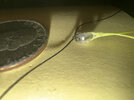what is the significance of backdriveability for the joints?
"Springiness" - shock loads are a part of normal movements, at anything above ultra low-speed motions.
Also such as balance when picking up or being passed an item, and on uneven surfaces where weight load is proportioned between the legs.
Specifically, both fast and unexpected motions; at anything above a very slow walk, there are inertial loads to be compensated for at every step. joints "spring" slightly with each change of load.
The human/animal muscle "force control" you asked about - eg. If someone passes you something heavy like a bag of cement by dropping it on your outstretched arms, your arms drop to absorb the sudden shock loading, rather than the impact being passed in full. Then your reflexes kick in and apply more force to hold it level to carry.
Likewise when you step or jump off something - you either step on to the ball of your foot and your calf muscles take the impact, or you land with knees bent and your legs bend further to absorb the impact.
Landing from even a couple of feet up with legs straight and flat-footed shocks all your joints badly - much higher and it breaks things! - Muscles are effectively like controlled springs, nothing like normal geared motor servos
The MIT "Cheetah" joint motors are a good example - very high torque with a low ratio (~6:1) planetary gear included, so there is next to no drag when back driving them, unless torque is being applied.
For heavy joints such as major arm & leg joints, if they cannot back-drive just through the weight of the limb and stand impacts of the body weight or sudden significant loads, they will break somewhere in use.
And motions will not be human-like.
A stiff spring connection between the actuator and limb + feedback device can act in a similar way, to some extent for smaller joints. If the actuator itself also has feedback, the difference between the two positions gives a measurement of the force being applied.
ps. If you try to use human bone models, you need to replicate all the supporting ligaments etc. to keep the joints stable in other planes, as well as tendon/muscle equivalents to control wanted motion.
Mechanical joints that can only move in the required axis or axes are far more stable, as well as leaving more room for the control parts.




